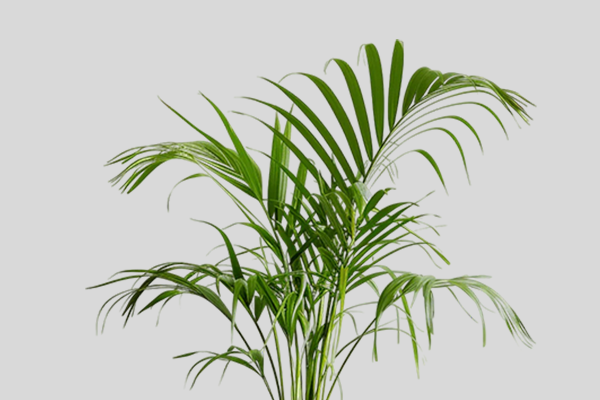
Dypsis lutescens
Dypsis lutescens, also known as the Areca Palm or “Golden Palm,” is one of the most popular houseplants. Native to Madagascar and the Comoros Islands, its lush, arching fronds bring a tropical atmosphere indoors, humidifying the air, enriching it with oxygen, and filtering toxins such as toluene and formaldehyde. Areca care is relatively simple, though it requires attention to the species’ specific needs.
Placement
The Areca Palm thrives in bright, indirect light. The best spots are east- or west-facing windows. On the south side, it can also grow well if protected from direct sun. In low light, the palm becomes leggy, and its foliage loses density and color. Dypsis dislikes frequent relocation, so it is best to choose a permanent spot from the start.
Watering
Dypsis prefers evenly moist soil. In summer, water 2–3 times per week; in winter, about once every 7–10 days. The soil should never fully dry out, but overwatering must also be avoided, as it leads to root rot. Use soft, filtered, or settled room-temperature water. The palm also loves high humidity, so misting the leaves or placing a water container nearby is beneficial.
Feeding
From spring until late summer, feed the Areca Palm every two weeks with a balanced fertilizer for ornamental foliage plants. Feeding is reduced to a minimum or stopped completely in autumn and winter. Regular feeding ensures vigorous growth and vibrant green fronds.
Repotting
Young palms should be repotted annually in spring. Mature plants only need repotting every 2–3 years. Use a wide but not too deep pot with good drainage. The soil should be light and nutrient-rich: a mix of garden soil, compost, peat, and sand (pH 6.5). Ready-made palm substrates may also be used, with coconut chips as a loosener. If repotting is not planned, simply replace the top layer of soil.
Temperature
Dypsis thrives at +20…+26 °C. Short drops to +18 °C are acceptable, but anything lower causes stress. Winter drafts and cold air are harmful, and the palm is not frost-resistant. It can be taken outdoors only in warm weather, avoiding chilly nights.
Pruning
Pruning is rarely needed. Only dried or damaged leaves at the base should be removed. Green fronds should not be cut, as this weakens the plant and slows its growth. If the Dypsis becomes overly dense, light thinning in spring will improve air circulation within the crown.
Conclusion
Dypsis lutescens is a tropical palm that can grow up to 2 meters indoors, making it a striking decorative accent for homes and offices. Its care requirements include bright indirect light, regular but moderate watering, seasonal feeding, occasional repotting, stable temperatures, and simple leaf maintenance. Under the right conditions, the Areca Palm will remain lush and decorative for many years, bringing freshness and tropical charm to your space.
